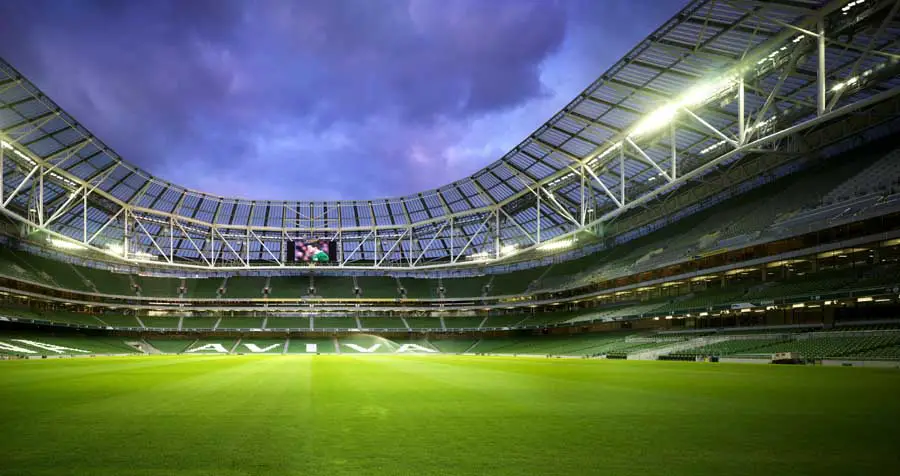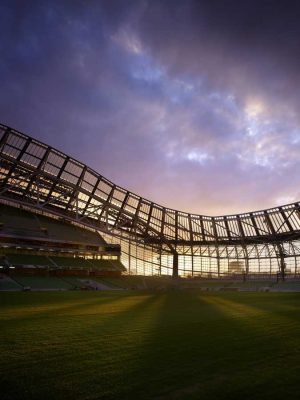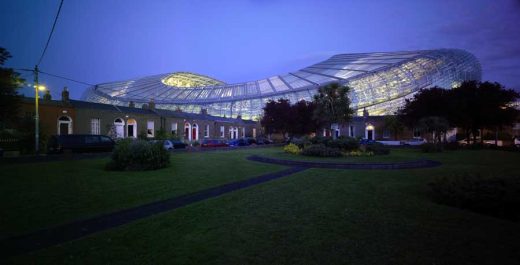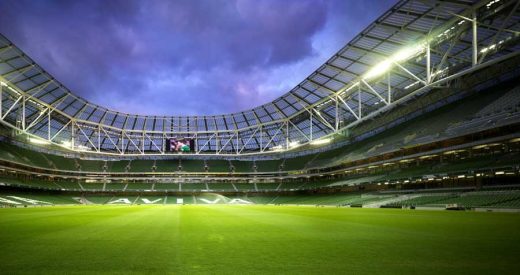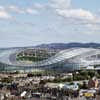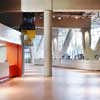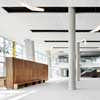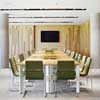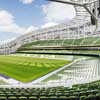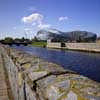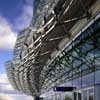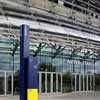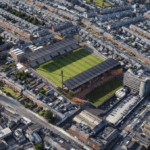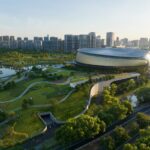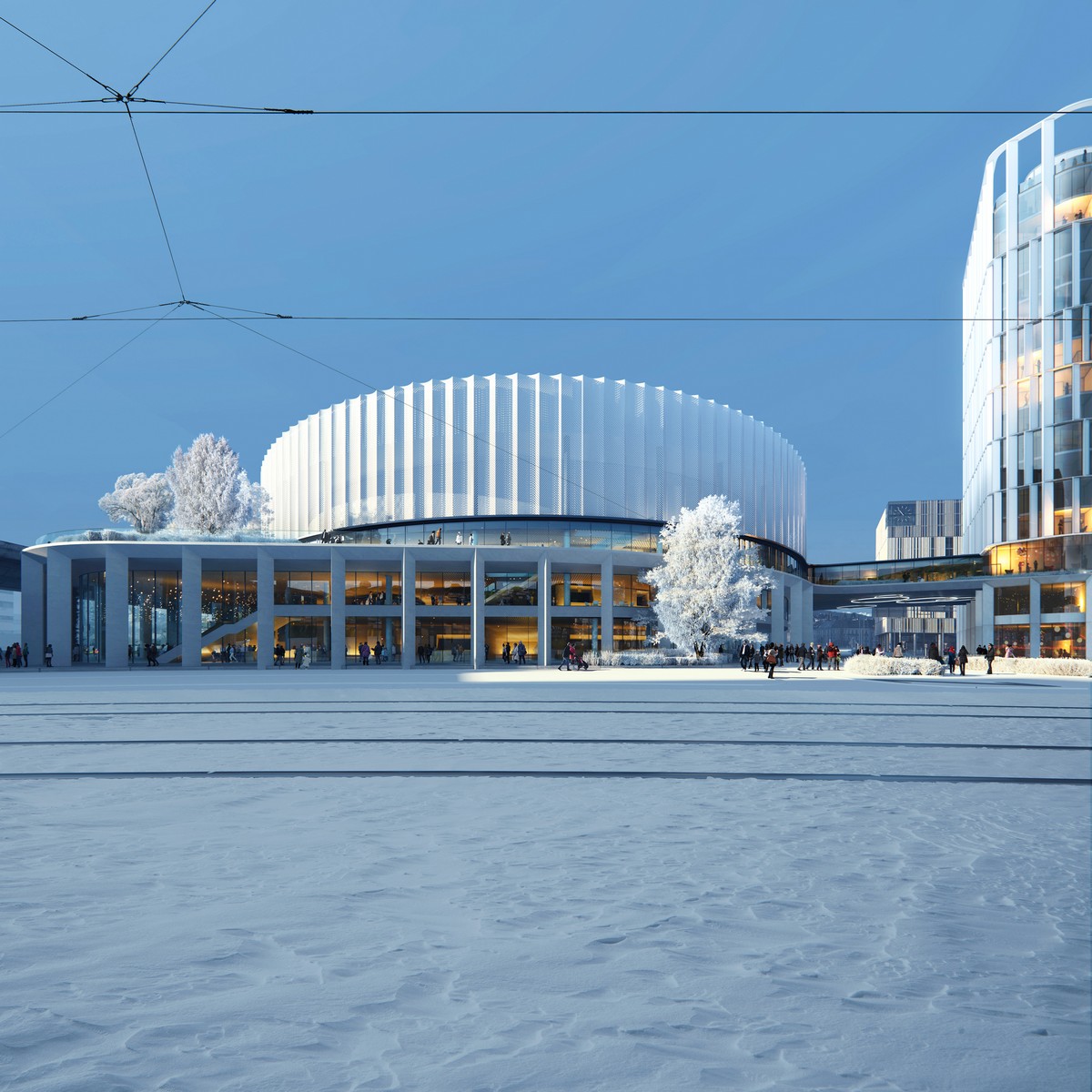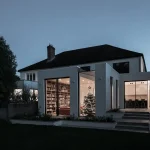Aviva Stadium, Dublin Arena Building, Populous Project Photos, Ground Design News
Aviva Stadium Dublin
Arena Building Development Ireland: Architecture design by Populous Architects in Ireland
20 Aug 2010
Architect: Populous ; Local architect Scott Tallon Walker
Avivia Stadium Building
Aviva Stadium
Populous has been developing the use of parametric based design in stadium typographies since 2005. The first project to be a platform for the company’s work was the Aviva Stadium in Dublin, Ireland. With the Aviva Stadium project Populous undertook the design development and co-ordination of production information using a combination of McNeel’s Rhinoceros and Bentley’s Generative Components programs.
The project brief was specific in maintaining the historical site on Lansdowne road and replacing the existing stadium with a modern 50,000 all seated-stadium. The Aviva Stadium was to hold the home games for Irish international rugby and the Irish football team.
Design
The scheme design of the stadium was developed to be both responsive and empathetic to the surrounding neighborhood. Providing an organic translucent form allowing maximum amount of daylight into the seating tiers and onto the surrounding built environment and minimizing the impact of the new stadium on existing buildings.
The form of the exterior skin enveloped both the roof structure and the façade structure, combining both elements into one controlling form. This concept emphasized the importance that the form of the building held, as the form needed to accommodate all tolerances and technical requirements of both the façade and the roof elements, into one three dimensional setout model.
Initial studies and concepts were undertaken using a combination of 3D programs, firstly McNeels Rhinoceros platform. 3D models were built up using a combination of tangential arcs based on structural grids of the building. These first stages of work allowed Populous to explore the development and logic to the forms’ geometry in basic setout arcs and lines, thus testing the use of a combination of simple geometric constructions to achieve the desired shape.
Once the logic of a two arc plus one line construction was tested around the circumference of the building the geometry of the model was rebuilt within Bentleys Generative Components. It’s important to note that at this stage we were dealing with the development of a setting out surface or skin from which the rest of the architectural and structural elements would be setout.
The anticipation of a design evolution of the shape of the building through all these elements was paramount to the construction of the Generative Components model. Thus certain variables and base principles where established within the Generative Components model allowing Populous to maintain control over the final form of the model.
This allowed the model to be classed as parametric, having internally defined variables, but also restraining the geometry to certain girds and given base extremities. For Populous this was the most critical single aspect of the parametric design as the finished construction would result directly from the shape of the parametric skin of the building thus not allowing for any deviations from the base geometry to go unnoticed.
Architectural and Structural Parametric Development
Having established a 3D parametric model, which held the basis to the setting out of the façade and the roof structure, attention was then focused on the implementation of all other elements from this controlling shape. Working closely with Buro Happolds we established the setting out principles by which the structural roof members would relate to the parametric skin.
We needed to develop a frame-work by which the information between both forms could be translated Populous ultimately driving the form and cladding of the building and Buro Happolds driving the structural member sizing / positioning. For this we simplified the gct script to produce the skin in one gct file and referenced into this file base setout principle figures and information from an external excel spread sheet.
Thus both Populous and Buro Happolds could work simultaneously on the model at different offices, Buros further developing the structural members on top of the original gct file and Populous further developing the cladding layout again on top of the original gct file. With the underlying frame to both
firms models being dependent on the base figures within the excel document Populous ultimately could amend and refine the skin’s form by altering the established variable figures within excel. Making inter office co-ordination between the two firms rely in the transfer of a single excel document. Due to the relationship between façade skin and roof structure and also due to the geometric principle of the form defining both, any amendment to values or the shape of the building at a lower level would have a knock on effect to the form of the roof shape above.
For this reason the parametric relationship and the combined use of Generative Components across both offices allowed Populous to amend the form to certain criteria, such as floor width requirements, floor area ratio figures, or even beautifying of the shape, by calculating the variation to the shape amending the excel document to reflect the desired change to the form and sending an updated excel spread sheet to Buro Happolds to reflect the changes.
Thus Buro Happolds developed a structural model with all 3500 tones of structural members in it that could be rerun and reloaded using an altered set of base figures to reflect our architectural requirements.
Architectural Façade Development
With the architectural form and structural scheme in progression Populous further used Generative Components in the design development of the façade. Using the form of the skin as a base we ran numerous panel tests over the shape to analyse different panel arrangements. The quick succession that we could populate a shape allowed us to quickly verify or omit options of cladding formations.
Once a logic to a cladding scheme was developed we concentrated in more detail on the technical dimensions and sizing of the panels and brackets. Once detailed sizing and loading studies were completed to size the brackets we further used the parametric software to populate the surface with all the panels and brackets setout data. We embedded drawn blocks as cross-hairs and used these as the setout datum points for each part of the bracket and panel alike.
This embedded information was further extracted back to numerous excel spread sheets listing each panels size, location and rotation about the major façade mullions. These façade mullions were in direct relation to the established skin. All of the outputted data was used in direct combination with the resulting 3D wireframe model as construction information for the façade contractor. Likewise the wireframe model developed by Buro Happolds was used as the construction setout information for the steel contractor to work to.
Facade Bracket Detailed Design
The sum of all the generated modeling gave Populous a number of over 4,000 individual panels to cover the building façade alone, with each of these panels and supporting brackets requiring an individual placement and rotation, In order to optimize the fabrication cost and installation process we develop a double rotation support bracket for the louvers.
This was comprised of two parts, the first attached to the mullion at 1 meter intervals down the mullion and was allowed to be placed about the mullions vertical rotation (See Fig 1 – bracket rotation around mullion), the second part a ‘V’ shaped element placed onto the face of the first bracket and allowed to rotate about the mullions horizontal (See Fig2 – V bracket rotation). To the ‘V’ shaped bracket the axel for each façade panel could be supported.
Upon this axel the polycarbonate façade panel was fixed into a predefined position providing the open rotation on the elevation (See Fig 3 – louver axel rotation). This design allowed a two part cast aluminum bracket to support all different positions of all 4,000 façade panels. The data and rotation of each assembly was extracted from the parametric model into excel spread sheets for the assembly process. The aesthetic result is a unified detailed design allowing a sinuous complexity to encapsulate the whole building.
Summary
Throughout the process of the project from refinement of form to setout of detailed production information the parametric process has been central in aiding not only the architect but also the engineer in delivering co-ordinated information. There is no doubt that the whole process could have been done in a non parametric model and developed through numerous redrawing and remodeling of
forms and geometry. But given the complexity of the design in hand and the numerous elements that were co-ordianted across different offices following a non parametric approach to this design would have opened the possibility to more errors. Also the time allocated to delivering the design would increase significantly, hence using parametric design allows designers to quickly assess schemes and layouts over complex forms in shorter amounts of time in order to get to the desired solution faster whilst eliminating basic human error.
Parametric use in architecture is a method by which interrelationships and calculations can be defined and bound into architectural 3D or 2D models. The process to establish a model or a geometry may take longer in the short term but it has beneficial results in the numerous calculations it can compute in the long-term over a vast number of elements.
The process is a development of the electronic calculator by programming into a tool for defining geometry with bound in formulae.
In much the same way that the calculator has evolved from the human driven abacus to the first mechanical calculators of Charles Babbage in the 19th century to the present day electronic calculator we know and use today, architectural geometry through necessity and evolution of design is pushing the CAD driven platform from a user driven interface to a calculated and parametric relationship of information.
Without this evolved geometric relationship projects like the Aviva Stadium would not have been architecturally feasible in a time and budget driven environment. With these tools it allows the designer to further push the boundaries of the architectural form without compromising on cost and time constraints.
Energy efficiency and eco-friendly measures
The building incorporates several green initiatives – an efficient steel and concrete structure to minimise the weight of steel used, recycled blast-furnace slag in the concrete mix to reduce cement and thereby the energy content, harvesting of rainwater to be used for watering the pitch, the use of waste heat from the generators to warm water for the toilets, as well as efficient controls on the services to reduce waste energy use.
Aviva Stadium Dublin images / information from Populous architects
Populous architects
Aviva Stadium is shortlisted for the LEAF Awards 2011
LEAF Awards : Shortlisted Buildings + Architects
Location: Aviva Stadium, Dublin, Ireland
Dublin Architecture
Dublin Buildings – Selection
Dublin Spire
Ian Ritchie Architects
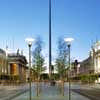
photo from Ian Ritchie Architects
Grand Canal Square Dublin
Studio Daniel Libeskind
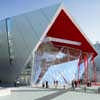
Adamstown Central
Metropolitan Workshop

Dublin Market
HKR Architects with make and Gehl Architects

image © make architects
Comments / photos for the Aviva Stadium Dublin Architecture page welcome

